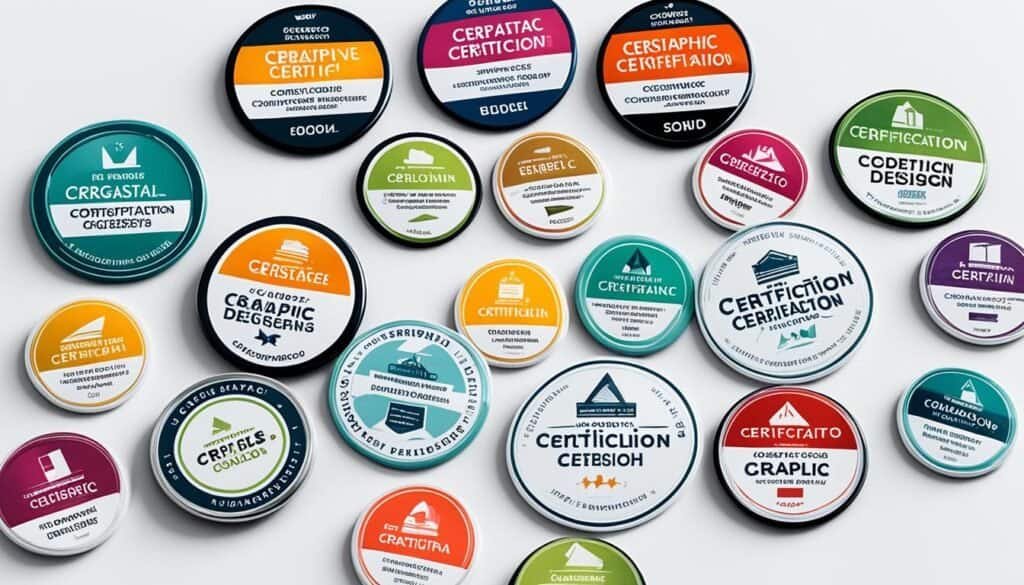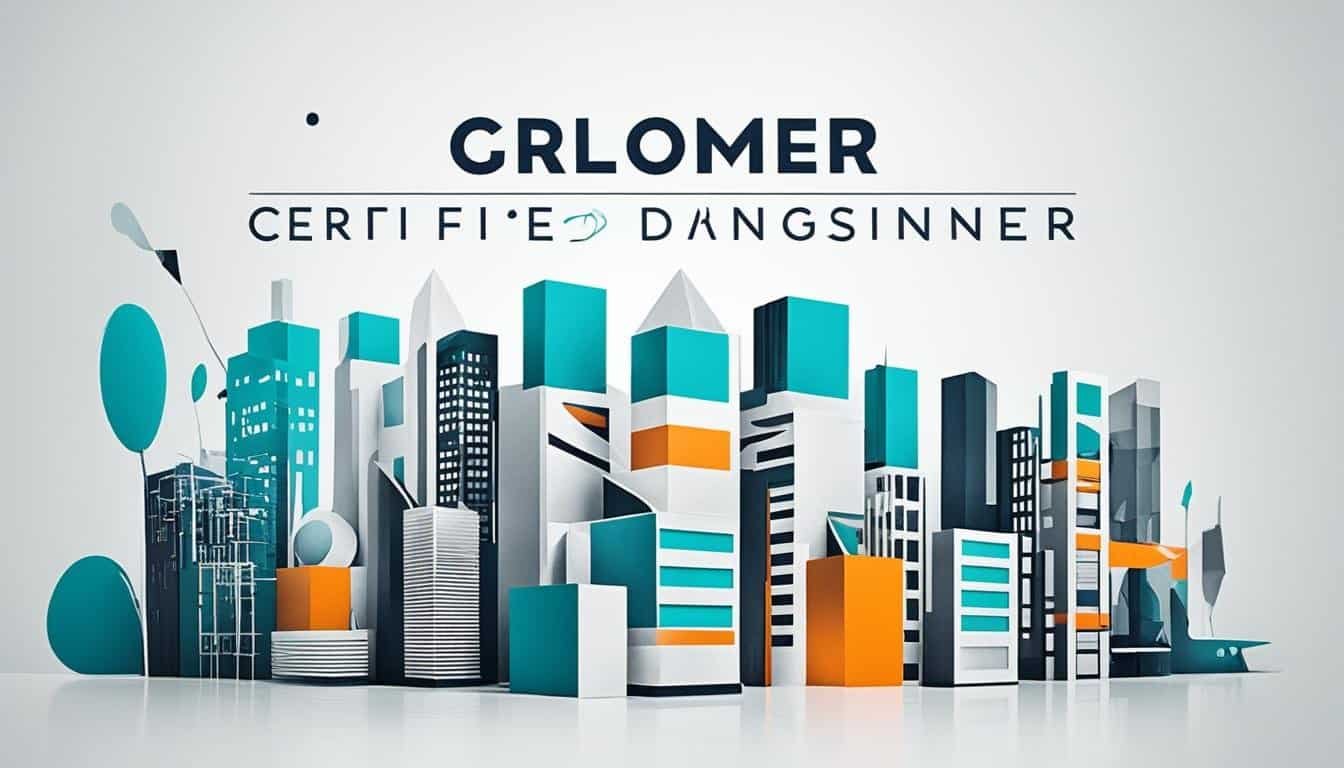Certified Graphic Designer
Did you know that individuals with a graphic design certification earn an average of 20% more than their non-certified counterparts? That’s right – by getting certified as a graphic designer, you can not only enhance your skills and knowledge but also increase your earning potential in the ever-evolving world of design.
With the growing demand for visually appealing content in marketing campaigns, web design, and various industries, becoming a certified graphic designer is a strategic move to differentiate yourself from the competition and secure lucrative career opportunities. Whether you’re a seasoned designer looking to validate your expertise or a beginner seeking a pathway into the industry, a graphic design certification can open doors to success.
Here, we will explore the intricacies of a graphic design certification, delve into the essential skills and roles of graphic designers, and guide you through the process of choosing the right certification program for your professional growth. By the end, you’ll be equipped with the knowledge and insights needed to embark on a fulfilling journey as a certified graphic designer.
Key Takeaways:
- A graphic design certification can increase your earning potential by 20% compared to non-certified designers.
- Becoming a certified graphic designer opens up a wide range of career opportunities and sets you apart from the competition.
- Graphic design certifications validate your expertise and enhance your credibility in the industry.
- By choosing the right certification program, you can develop specialized skills and gain industry recognition.
- Obtaining a graphic design certification is an investment in your professional development and future success.
What is a Graphic Designer?
A graphic designer is a professional within the visual arts realm who combines technical skills and creative talents to design informative, appealing, and memorable content. They work with clients and other designers to develop a project’s overall look and feel, assembling visual elements like text, typography, images, and motion graphics.
Graphic designers play a crucial role in various industries, including advertising, marketing, publishing, and web design. They use their expertise in design principles, color theory, and composition to create visually captivating materials that effectively communicate a message or tell a story.
With a deep understanding of visual communication, graphic designers utilize their creative flair and technical proficiency in software like Adobe Illustrator and Photoshop to produce designs that capture attention and engage audiences. Whether it’s crafting compelling advertisements, designing eye-catching logos, or creating stunning digital illustrations, graphic designers are skilled in transforming concepts and ideas into visually appealing visual representations.
In addition to their technical skills, graphic designers possess a keen eye for aesthetics and a strong sense of visual storytelling. They have the ability to interpret client briefs, understand target audiences, and translate ideas into captivating designs that effectively convey a brand’s message or vision.
Furthermore, collaboration and communication are essential aspects of a graphic designer’s work. They often work closely with clients, marketing teams, and other designers to ensure that the creative direction aligns with the client’s objectives and brand identity. Effective communication skills and the ability to listen, interpret feedback, and implement changes are critical in producing successful designs.
Overall, graphic designers are skilled professionals who bring together both technical expertise and artistic creativity to create visually compelling content. Their work enhances the visual communication of brands, products, and messages, making them an integral part of the creative industry.
Common Graphic Designer Jobs
Graphic designers play a vital role in various industries, taking on diverse job roles that cater to the specific needs of each sector. Here are some common graphic designer jobs:
1. Animators
Animators are graphic designers who bring static images to life through captivating animations. They use their artistic skills and knowledge of motion graphics to create visually appealing and engaging animated content. From animated advertisements to character animations for games and movies, animators add life and movement to static visuals.
2. Production Artists
Production artists are graphic design professionals who predominantly work in the print and advertising industry. They are experts in translating design concepts into high-quality print-ready materials, such as brochures, posters, packaging, and billboards. Their attention to detail and technical expertise ensure that the final products meet clients’ specifications and standards.
3. Product Designers
Product designers focus on creating visual designs for physical products. They collaborate with engineers, marketing teams, and other stakeholders to develop product aesthetics that are visually appealing, functional, and aligned with the brand’s identity. Whether it’s designing the packaging for a new consumer product or improving the user interface of a tech gadget, product designers play a crucial role in enhancing the user experience.
4. Multimedia Designers
Multimedia designers specialize in creating interactive content for digital platforms. They combine graphic design with code and technology to develop visually stunning websites, mobile applications, user interfaces, and multimedia presentations. Their work includes integrating audio, video, animation, and interactive elements to deliver engaging and user-friendly digital experiences.
5. UX/UI Designers
UX/UI designers focus on enhancing the user experience and interface design of digital products and services. They conduct user research, gather insights, and apply design principles to create seamless and intuitive user experiences. UX/UI designers collaborate closely with developers and product managers to ensure that their designs align with user needs, business goals, and industry best practices.
6. Creative/Art Directors
Creative or art directors are experienced graphic designers who lead design teams and oversee the creative direction of projects. They are responsible for conceptualizing and implementing design strategies, managing client relationships, and ensuring that the final deliverables meet the desired visual standards. Creative/art directors play a crucial role in guiding the design process and ensuring the successful execution of creative projects.
7. Brand Identity Designers
Brand identity designers are specialists in developing visual identities for companies and products. They create logos, color schemes, typography, and other brand elements that effectively communicate the brand’s values, personality, and message. Brand identity designers ensure consistency in the visual representation of a brand across different platforms and media.
No matter the industry or job role, graphic designers bring their unique skills and creativity to visually communicate messages and enhance the overall visual experience.
Why Graphic Design is an In-Demand Career
Graphic design has emerged as a highly sought-after career in today’s job market. Skilled graphic designers play a pivotal role in creating captivating marketing campaigns that drive business success. With the increasing reliance on digital tools and the rise of remote work, graphic designers can now work from anywhere in the world, making this profession not only flexible but also in high demand.
Effective marketing campaigns require visually appealing and engaging content that captures the attention of target audiences. Graphic designers possess the creative expertise to conceptualize and design compelling visuals that communicate brand messages effectively. By utilizing their artistic skills and knowledge of design principles, graphic designers bring life to marketing materials, ranging from social media visuals and websites to print advertisements and packaging designs.
“Graphic designers possess the creative expertise to conceptualize and design compelling visuals that communicate brand messages effectively.”
Furthermore, the growth of remote work opportunities has opened up a world of possibilities for graphic designers. With the ability to work remotely, graphic designers are no longer limited by geographical boundaries. They can collaborate with clients from different parts of the world, expanding their client base and networking opportunities. Remote work also provides the flexibility to work at one’s own pace, leading to increased productivity and work-life balance.
“The rise of remote work enables graphic designers to collaborate with clients from different parts of the world, expanding their client base and networking opportunities.”
Moreover, the global shift towards digital marketing has significantly increased the demand for skilled graphic designers. As businesses strive to establish a strong online presence, they require professionals who can create visually captivating content for their websites, social media platforms, and online advertising campaigns. Graphic designers with expertise in digital marketing techniques and trends have a competitive advantage in the job market, as they can bring valuable insights into creating impactful online visuals.
In conclusion, the graphic design field offers a rewarding and fulfilling career path. The demand for graphic designers continues to grow due to their unique ability to create visually appealing marketing campaigns. With the flexibility of remote work and the increasing importance of digital marketing, graphic design professionals have abundant opportunities to contribute to the success of businesses and thrive in a dynamic and evolving industry.
| Benefits of Graphic Design Career |
|---|
| 1. High demand in the job market |
| 2. Flexibility to work remotely |
| 3. Opportunity to create captivating marketing campaigns |
| 4. Scope for global collaboration |
| 5. Ability to contribute to businesses’ success |
What Graphic Designers Do
Graphic designers play a vital role in enhancing the visual appearance of information and messages through their artistic abilities. Their specific duties vary depending on the industry they work in, but their creative input is essential to creating impactful designs.
Designers in Publishing
In the publishing industry, graphic designers create captivating designs for a range of print and digital materials. This includes books, newspapers, magazines, and online publications. They work closely with authors, editors, and layout specialists to bring the content to life with visually appealing layouts, typography, and images.
Designers in Advertising
Graphic designers in advertising focus on promoting commercial products and services through visually appealing designs. They collaborate with clients, marketing teams, and copywriters to create eye-catching packaging designs, advertisements for print and digital media, and compelling visual elements that effectively communicate the brand’s message.
Design Principles
In their work, graphic designers apply various design principles to achieve aesthetically pleasing and functional designs. These principles include balance, which involves distributing visual elements harmoniously; contrast, which creates visual interest through differences in color, size, and typography; and alignment, which ensures that elements are properly placed and organized.
The Power of Visual Appearance
The visual appearance of a design can greatly impact its effectiveness in capturing attention and conveying the intended message. Graphic designers have the expertise to select appropriate colors, fonts, images, and layouts that resonate with the target audience and evoke the desired emotional response.
“Design is not just what it looks like and feels like. Design is how it works.” – Steve Jobs
By considering the principles of design and leveraging their artistic skills, graphic designers work tirelessly to create visually compelling designs that communicate messages effectively and leave a lasting impact on the viewers.
Five Steps to Becoming a Graphic Designer
Becoming a successful graphic designer requires a combination of design theory knowledge, technical skills, and a solid portfolio. Follow these five steps to kickstart your journey:
-
Understand Design Theory
Design theory forms the foundation of effective graphic design. Familiarize yourself with concepts like color theory, composition, typography, and visual hierarchy. This knowledge will help you create visually appealing and impactful designs.
-
Gain Technical Skills
Mastering graphic design software is crucial for success in this field. Learn industry-standard programs like Adobe Illustrator and Adobe Photoshop. These tools will enable you to bring your creative vision to life and efficiently execute design projects.
-
Build an Online Portfolio
An online portfolio is a showcase of your best design work. Create a visually engaging website or utilize platforms like Behance or Dribbble to highlight your projects. Regularly update your portfolio with new pieces to demonstrate your evolving skills and style.
-
Find a Specialty
Graphic design encompasses a wide range of disciplines. Determine your area of interest and specialize in it. Whether it’s branding, web design, motion graphics, or print design, focusing on a niche will allow you to refine your skills and become an expert in that specific field.
-
Consider Getting Certified
Earning graphic design certifications can enhance your credibility and open up new career opportunities. Consider certifications like the Adobe Certified Expert (ACE) or other industry-recognized credentials that validate your expertise in graphic design.
“Becoming a graphic designer requires a blend of creativity, technical skills, and continuous learning. By following these steps, you can pave your way to a successful career in graphic design.”
| Step | Description |
|---|---|
| 1 | Understand Design Theory |
| 2 | Gain Technical Skills |
| 3 | Build an Online Portfolio |
| 4 | Find a Specialty |
| 5 | Consider Getting Certified |
Types of Graphic Design Certifications
When it comes to pursuing a career in graphic design, obtaining the right certifications can significantly boost your credentials and demonstrate your expertise in the field. There are several graphic design certifications available that cater to different aspects of the profession. Let’s take a closer look at some popular graphic design certifications:
1. Adobe Certified Expert (ACE) Certification: The ACE certification is offered by Adobe, the industry leader in graphic design software. This certification validates your skills and proficiency in using Adobe Creative Cloud applications like Photoshop, Illustrator, and InDesign. It is globally recognized and highly regarded by employers and clients in the design industry.
2. Graphic Design Certification by Coursera: Coursera offers a comprehensive Graphic Design Certification program that covers various design principles, techniques, and tools used in the industry. This certification provides a strong foundation in graphic design and allows you to showcase your skills and knowledge to potential employers.
3. Certified Graphic Designer (CGD) Certification: CGD certification is an internationally recognized credential that validates your expertise and professionalism as a graphic designer. This certification ensures that you possess the necessary skills in areas such as typography, layout design, color theory, and branding.
4. Certified Professional in Graphic Design (CPGD) Certification: The CPGD certification focuses on advanced graphic design skills and strategic thinking in design projects. This certification is ideal for experienced designers who want to further enhance their skills and credibility in the industry.
Each of these certifications offers unique benefits and focuses on different aspects of graphic design. It’s important to assess your career goals, skill level, and areas of interest to choose the certification that aligns with your needs. Whether you want to specialize in Adobe applications, develop a strong foundation in graphic design principles, or showcase your advanced design skills, there is a certification option available for you.

| Certification | Provider | Focus |
|---|---|---|
| Adobe Certified Expert (ACE) Certification | Adobe | Proficiency in Adobe Creative Cloud applications |
| Graphic Design Certification by Coursera | Coursera | Comprehensive graphic design skills and principles |
| Certified Graphic Designer (CGD) Certification | Various organizations | Expertise in typography, layout design, color theory, and branding |
| Certified Professional in Graphic Design (CPGD) Certification | Professional associations | Advanced graphic design skills and strategic thinking |
Choosing the Right Graphic Design Certification
When deciding on a graphic design certification program, it’s crucial to consider various factors to ensure it aligns with your specific requirements and goals. Here are key aspects to evaluate:
1. Requirements
Examine the prerequisites set by the certification program. Some certifications may require a minimum level of experience or specific educational qualifications. Make sure you meet these requirements before enrolling.
2. Learning Outcomes
Research the learning outcomes of the certification program. Evaluate whether the curriculum covers essential graphic design skills, design principles, software proficiency, and industry-specific knowledge. Analyze how these outcomes align with your desired skillset and career aspirations.
3. Costs
Consider the financial investment required for the certification program. Compare the costs of different programs, including tuition fees, study materials, and any additional expenses. Remember to weigh the value of the certification against its costs to make an informed decision.
4. Duration
Assess the duration of the certification program, including the time required for completing coursework, projects, and any examinations. Consider how the program’s duration fits into your schedule and whether you can dedicate the necessary time to successfully complete the program.
5. Industry Recognition
Evaluate the industry recognition and reputation of the certification program. Look for certifications that are widely recognized and respected within the graphic design industry. This will enhance your employability and professional credibility.
“Choosing the right graphic design certification program is essential for your career success. It’s important to evaluate the requirements, learning outcomes, costs, duration, and industry recognition when making your decision.”
By considering these factors, you can make an informed decision and select a graphic design certification program that best aligns with your goals and aspirations. Remember that each certification program has its unique features, so take the time to research and choose the program that will provide you with the knowledge and skills to thrive as a graphic designer.
Preparing for the Graphic Design Certification Exam
Once you’ve chosen a graphic design certification, it’s essential to prepare for the exam or project that will assess your skills. Proper preparation will increase your chances of success and boost your confidence during the evaluation process.
Review Exam Guidelines
Before diving into your study materials, carefully review the exam guidelines provided by the certification program. Familiarize yourself with the exam format, duration, and structure. This will help you understand what to expect and how to allocate your time effectively.
Study Certification Materials and Resources
Study the certification materials and resources provided by the program. These materials may include textbooks, online resources, video tutorials, and practice exercises. Take the time to thoroughly understand the concepts, theories, and techniques covered in the certification program.
Practice Your Skills
Practice is essential to hone your graphic design skills and become comfortable using the required software or tools. Set aside dedicated time each day to practice designing various types of projects. Experiment with different styles, layouts, and color schemes to expand your creativity and problem-solving abilities.
Seek Feedback from Other Designers
Engage with fellow graphic designers or industry professionals to seek feedback on your work. They can provide valuable insights, constructive criticism, and suggestions for improvement. Join online design communities, participate in forums, and attend design events to connect with other designers and learn from their experiences.
Take Mock Exams
Conducting mock exams is an excellent way to familiarize yourself with the exam format and types of questions you may encounter. Seek out mock exams specifically designed for your chosen certification program. These practice exams will help you identify areas where you need improvement and become more comfortable with the time constraints of the actual exam.
By following these guidelines and dedicating time and effort to your preparation, you’ll be well-equipped to demonstrate your graphic design skills and knowledge during the certification exam. Remember to stay focused, practice regularly, and approach the exam with confidence.
Benefits of Graphic Design Certifications
Obtaining a graphic design certification offers several benefits for aspiring designers. By pursuing a certification, you can:
- Validate your skills: Graphic design certifications provide a formal validation of your skills and expertise in the field. They demonstrate that you have the necessary knowledge and competence to excel in various aspects of graphic design.
- Enhance your credibility: In the competitive world of design, certifications add credibility to your profile. They act as a testament to your commitment to professional development and dedication towards mastering your craft.
- Advance your career: Having a graphic design certification can open doors to new career opportunities. Certified designers are often preferred by employers and clients due to their proven competence. This can lead to higher job prospects, better salary packages, and increased responsibilities.
Moreover, graphic design certifications provide you with a competitive edge in the job market. They differentiate you from your peers and demonstrate your commitment to continuous learning and growth. Employers value certified designers for their up-to-date knowledge, industry-relevant skills, and ability to deliver high-quality design solutions.
“Obtaining a graphic design certification can significantly enhance your skills, credibility, and career prospects as a certified graphic designer.”
Comparison of Popular Graphic Design Certifications
| Certification Name | Provider | Focus Areas | Price | Duration | Industry Recognition |
|---|---|---|---|---|---|
| Adobe Certified Expert (ACE) | Adobe | Adobe Creative Cloud applications | $180 (per exam) | Varies | High |
| Graphic Design Certification | Coursera | Design fundamentals, visual communication, software skills | $49 per month (Coursera Plus subscription) | Flexible (self-paced) | Recognized by industry leaders |
| Certified Graphic Designer (CGD) | The Graphic Artists Guild | Design principles, client management, ethical practices | $225 (Guild members) $325 (Non-members) |
Varies | Respected in the design community |
| Certified Professional in Graphic Design (CPGD) | American Design Association | Design theory, typography, branding | $325 (Exam fee) | Varies | Industry-recognized certification |
It is essential to choose a certification that aligns with your goals, budget, and learning preferences. Consider factors such as the focus areas, price, duration, and industry recognition when selecting the right graphic design certification for your career path.
By earning a graphic design certification, you can boost your professional reputation, gain valuable skills, and unlock new opportunities in the dynamic world of design.
Conclusion
Obtaining a graphic design certification can be a game-changer for your career. Not only does it enhance your skills and knowledge, but it also boosts your credibility as a certified graphic designer. With online certification programs readily available, gaining recognition and validation for your graphic design expertise has never been more accessible.
By becoming a certified graphic designer, you open doors to a world of professional development opportunities. You gain a competitive edge in a constantly evolving industry, positioning yourself for career growth and advancement. Employers and clients value the expertise and commitment that come with a graphic design certification, making you a sought-after professional in the field.
So whether you are an aspiring graphic designer looking to break into the industry or an experienced designer looking to sharpen your skills, starting your journey towards a graphic design certification is a wise investment. Elevate your career in the exciting world of professional graphic design and unlock your full potential today.
FAQ
What is a Certified Graphic Designer?
A certified graphic designer is a professional within the visual arts realm who has obtained a graphic design certification, validating their skills and expertise in the field.
What does a Graphic Designer do?
A graphic designer combines technical skills and creative talents to design informative, appealing, and memorable content. They work with clients and other designers to develop a project’s overall look and feel, assembling visual elements like text, typography, images, and motion graphics.
What are some common Graphic Designer jobs?
Some common graphic designer jobs include animators, production artists, product designers, multimedia designers, UX/UI designers, creative/art directors, and brand identity designers.
Why is Graphic Design an in-demand career?
Graphic design professionals play a crucial role in creating engaging marketing campaigns that contribute to the success of businesses. With digital tools and the rise of remote work, graphic designers can often work from anywhere in the world, making it a flexible and in-demand career choice.
What do Graphic Designers do to enhance the visual appearance of information or messages?
Graphic designers use their artistic abilities to enhance the visual appearance of information or messages. Their specific duties vary based on the industry they work in, such as designing print and digital books, newspapers, magazines, or promoting commercial products through packaging and visual elements.
What are the steps to becoming a Graphic Designer?
To become a graphic designer, it’s important to understand design theory, gain technical skills in graphic design software like Adobe Illustrator and Photoshop, build an online portfolio, find a specialty within graphic design, and consider getting certified to enhance your resume.
What types of Graphic Design certifications are available?
There are various types of graphic design certifications available, such as the Adobe Certified Expert (ACE) certification, the Graphic Design Certification by Coursera, the Certified Graphic Designer (CGD) certification, and the Certified Professional in Graphic Design (CPGD) certification.
How do I choose the right Graphic Design certification?
When choosing a graphic design certification, consider factors like the requirements, learning outcomes, costs, duration, and industry recognition. It’s important to select a certification that aligns with your skill level, specialization, and career goals.
How can I prepare for the Graphic Design certification exam?
To prepare for the exam, review the exam guidelines, study the certification materials and resources, practice your skills using the required software or tools, seek feedback from other designers, and take mock exams to familiarize yourself with the format and questions.
What are the benefits of Graphic Design certifications?
Obtaining a graphic design certification offers several benefits, including validation of your skills, enhanced credibility as a designer, and increased opportunities for career advancement. Certifications demonstrate your expertise and dedication to the field, making you more competitive in the job market.







